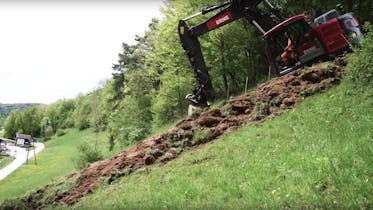
Electricity is an omnipresent part of our life that we often take for granted. Without it, our social and economic life would cease to function. As the backbone of the Swiss electricity supply, the transmission grid plays a critical role in ensuring the security of supply. It is also vital for our country, our society and our economy, and this is reflected by the commitment by the experts at Swissgrid: the Swiss transmission grid is part of the Continental European interconnected grid and is one of the most secure and stable electricity grids in the world.
The grid needs to be modernised
This security has a price. Firstly, there are maintenance and operating costs. Secondly, the grid needs to be upgraded and expanded so it can meet the electricity supply challenges of the future. The driving forces behind this are the liberalisation of the electricity market as well as the transformation in electricity consumption and production: more nuclear and coal-fired power stations are expected to go offline in Europe in the coming years, and wind and solar power plants will feed more electricity into the grid. The resulting structural bottlenecks in the Swiss grid are already becoming apparent today. These bottlenecks must be eliminated to ensure the continued efficiency of the Swiss electricity system.
The modernisation of the transmission grid is therefore the key for a sustainable energy future. The experts at Swissgrid have transparently presented the necessary measures in the «Strategic Grid 2025» project. These measures also include the renovation of existing and construction of new extra-high-voltage lines.
Technology and terrain influence costs
The importance of the transmission grid is undisputed, but this is not the case for its influence on people and the environment. Some are bothered by impact of the pylons and conductors on the landscape and would rather see this infrastructure installed underground. As a result, Swissgrid prepares underground cable and overhead line versions for each grid project. The authorities decide which version is constructed.
The costs of constructing a new line depend on various factors, one of which is the selected line technology. An underground cable, which is to say, a line that is installed and operated underground, always costs more than an overhead line. The experts at Swissgrid reckon with the fact that, in a best-case scenario, an underground cable is twice as expensive and, in a worst-case scenario, ten times as expensive as an overhead line.
Another important factor is the terrain that needs to be crossed. It is easier and cheaper to build an overhead line on the Swiss Central Plateau than in the alpine regions. The same is true for underground cables. The costs of underground lines differ in each case. Besides the topography and the subsoil, infrastructure (such as roads or railway lines) that needs to be crossed also has an impact on the costs. When looking at the overall life cycle, maintaining underground cables is also more expensive than maintaining overhead lines, and rectifying damage is much more time-consuming and more expensive.
A first in Bözberg
Experience with underground cables is still relatively limited. A 1.3-kilometre-long section of an extra-high-voltage line was installed underground in Switzerland for the very first time as part of the Beznau – Birr grid project.
Together with the two transition structures, which connect the underground cable with the overhead lines, this resulted in costs of around CHF 20 million. Incidentally, this is precisely the amount the experts at Swissgrid had budgeted. When calculated over the entire life cycle, the overhead line would have cost around six times less. The Beznau – Birr project shows that average costs of around 10 to 15 million francs per kilometre are to be expected for similar underground cable projects on the Swiss Central Plateau.
But who exactly bears the costs for the transmission grid? Everyone who pays for electricity in Switzerland – the costs are shared by all. Swissgrid calculates the electricity tariffs each year. These are regulated by the Swiss Federal Electricity Commission (ElCom), which ensures that Swissgrid provides its services efficiently and cost-effectively.
The costs are not the be all and end all
When new lines are built, the costs are an important factor, but certainly not the only one. A monitoring group comprised of representatives of various federal offices, the affected cantons, environmental associations and Swissgrid develops recommendations for the line route and the technology to be used. The work of the members of the monitoring group is based on the evaluation scheme for transmission lines. Regional development, the environment and economic viability are factors that are taken into consideration in addition to technical aspects. Whether and where an underground cable will be constructed is reassessed for every single project, and the final decision is ultimately reached by the Federal Council. Swissgrid implements the projects as stipulated by the authorities. The plans and budget for the construction are then reviewed by the regulator. Whether overhead or underground: an extra-high-voltage line always impacts the landscape.
The big picture
For the experts at Swissgrid, a line is never just a connection between two points; it is always one element of a huge network, the Swiss extra-high-voltage grid, which is integrated into the Continental European interconnected grid with 41 cross-border lines. This is something that also needs to be considered when new grid elements are planned. It also needs to be remembered that lines installed underground behave physically differently to those in the air. The more lines are placed underground, the greater the effects on the extra-high-voltage grid.
Although a secure and stable extra-high-voltage grid plays an essential role as a critical infrastructure for our country, its uninterrupted operation certainly cannot be taken for granted. It requires the dedication of Swissgrid’s experts, who work day and night to ensure both secure operation and the continued renovation and expansion of the grid.







